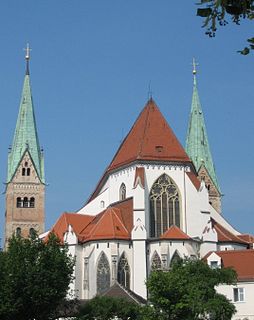Biography
Heinrich von Lichtenau was born in Mindelheim in 1444. [1] He was ordained as a priest in Augsburg in 1484. [1]

Mindelheim is a town in Swabia, Bavaria, Germany. The town is the capital of the Unterallgäu district. At various points in history it was the chief settlement of an eponymous state.

Augsburg is a city in Swabia, Bavaria, Germany. It is a university town and regional seat of the Regierungsbezirk Schwaben. Augsburg is an urban district and home to the institutions of the Landkreis Augsburg. It is the third-largest city in Bavaria with a population of 300,000 inhabitants, with 885,000 in its metropolitan area.
The cathedral chapter of Augsburg Cathedral elected him Prince-Bishop of Augsburg on 1 April 1505. [1] Pope Julius II confirmed his appointment on 7 May 1505, and he was consecrated as a bishop by Gabriel von Eyb, Bishop of Eichstätt, on 27 July 1505. [1]
According to both Anglican and Catholic canon law, a cathedral chapter is a college of clerics (chapter) formed to advise a bishop and, in the case of a vacancy of the episcopal see in some countries, to govern the diocese during the vacancy. These chapters are made up of canons and other officers, while in the Church of England chapters now includes a number of lay appointees; in the Roman Catholic Church their creation is the purview of the pope. They can be "numbered", in which case they are provided with a fixed "prebend", or "unnumbered", in which case the bishop indicates the number of canons according to the rents. In some Church of England cathedrals there are two such bodies, the lesser and greater chapters, which have different functions. The smaller body usually consists of the residentiary members and is included in the larger one.

The Cathedral of Augsburg is a Roman Catholic church in Augsburg, Bavaria, Germany, founded in the 11th century in Romanesque style, but with 14th-century Gothic additions. Together with the Basilica of St. Ulrich and Afra, it is one of the city's main attractions. It measures 113 x 40 m, and its towers are 62 m high. It is dedicated to the Visitation of Virgin Mary.

Pope Julius II, born Giuliano della Rovere, and nicknamed "The Fearsome Pope" and "The Warrior Pope", was head of the Catholic Church and ruler of the Papal States from 1 November 1503 to his death in 1513. His nine-year pontificate was marked by an active foreign policy, ambitious building projects, and patronage of the arts. His military and diplomatic interventions averted a take-over by France of the Italian States. He also proved a bulwark against Venetian expansionism.
He died on 12 April 1517. [1]














